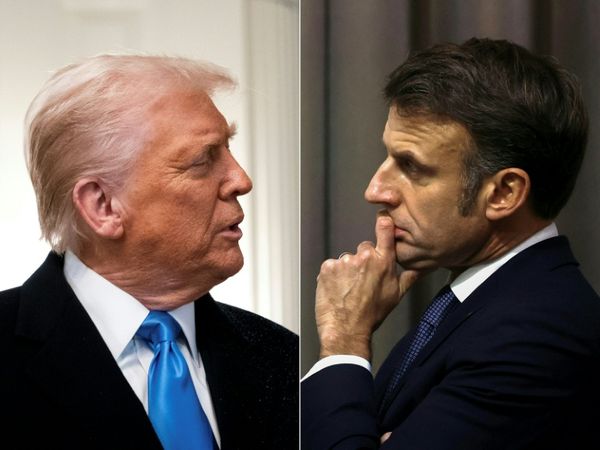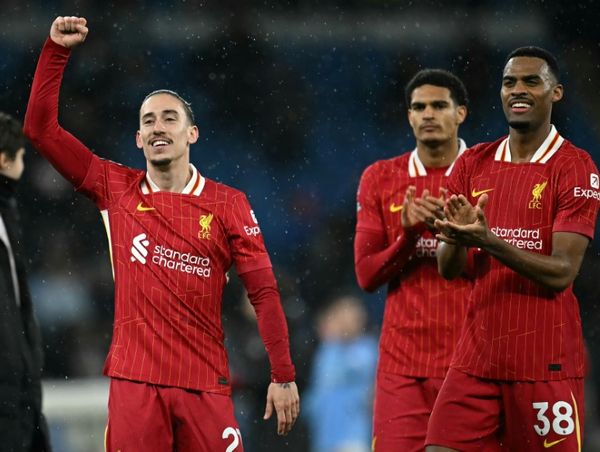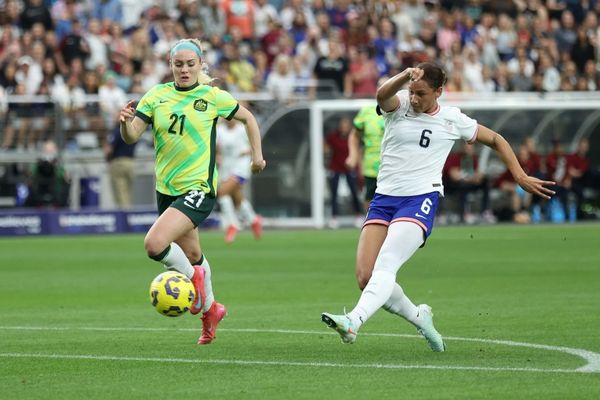
A toilet bubbles over with sticky yellow goo. Bedazzled executives are treated to a speech by a cartoon ghost. Someone’s dog walks across a wall before reconfiguring its own body parts. Alan Warburton has created some truly mind-blowing images for his new documentary The Wizard of AI. But what’s most impressive – or maybe most alarming – is the fact that he didn’t actually create any of them at all.
“I would say 99% of it was made using generative artificial intelligence tools,” says the 43-year-old artist film-maker. So could his 20-minute film really be, as he has claimed, the world’s first ever AI documentary?
“I’m taking a leaf out of the AI hype playbook there,” he admits with a laugh. “In truth, there is never going to be a first truly AI-generated documentary because it always will involve labour of some kind. Labour is what makes it watchable.”
The Wizard of AI is more than watchable. While trying to unpick both the hype and the terror that has arisen around AI, the documentary gleefully unloads a barrage of riotous images, from mutated, musclebound fish to vanishing genies via nuclear warhead top trump cards. It’s visually stunning and rattles along at a rollercoaster pace. But behind all the eye-candy is a subversive message – Warburton is using AI to warn us of the damage being done to artists and creatives by … AI itself.
“There are currently so many different new tools hitting the market and we hear from CEOs and tech evangelists about how revolutionary they are, but we don’t really hear from the people on the other side whose jobs are being impacted,” says Warburton. “I wanted to try to balance some of that AI hype with a little bit of advocacy for artists.”
The documentary’s smartest passage is one that tells the story of “the death of the artist” in the style of a noir graphic novel – with the AI programme Midjourney cast in the role of mafia boss/hitman. “Turns out the artist had been getting around a little too much, sharing everything – and that’s how they got him in the end,” says the narrator in full Noo-Yoik accent as we see a graphic designer sprawled on the floor, surrounded by pens, ink and crime tape.
The film, which was commissioned by the Open Data Institute, might have been made with AI but that doesn’t mean it didn’t take a lot of skill. “People have this idea that you can instantly convert your thoughts into a feature film,” says Warburton. “In reality, it’s a lot more complicated. You never get what you want. You get pushback from the platform. For example, if I try to get an image of the Chinese president, I can’t because they blocked it. So you have to find all these workarounds to get what you need.”

Warburton was constantly running into ethical concerns. Ask for a scene in a particular artist’s style, or even a loose genre, and you are inevitably ripping off other artists, whose lifetimes of training have been sucked into the AI generator. Warburton tried to avoid this as best as possible – for instance, in the graphic novel section he fed in his own drawings and asked the machine to build things around them.
This, however, leads into another issue: he was now feeding the AI machine with the content it needs to keep improving. “We start shaping it ourselves. We become complicit in it. If you use it, you pump it. If you disengage, you let other people pump it. There’s no winning strategy with AI.”
Warburton’s work over the years has incorporated animation, filmmaking and sculpture, among other things. Since 2016, he has been making a series of increasingly ambitious critical video essays about the impact of technology on visual culture, racking up over a million views with his intelligent musings on CGI and special effects.
Although this latest one was built from over 100GB of AI-generated content, Warburton acknowledges that it wasn’t entirely generated by AI. There is a brief clip of Kanye West in there, and an interview with the tech and arts writer Joanne McNeil, for instance. Plus, the script had no input from programmes such as ChatGPT – that was all written by Warburton himself, based on research he has conducted for his ongoing PhD in Digital Culture and Communication at Birkbeck’s Vasari Centre in London. “The script is the human anchor in the whole thing,” he says. “Plus, I think AI images are a lot better than AI-generated text – although that’s all about to change I’m afraid to warn you.”
In total, it took Warburton three weeks to make The Wizard of AI. He says if he had tried to make it just two years ago it would probably have taken a team of 10 people three months to make. “And it would have cost around £50,000. Although that’s a disingenuous comparison because no one would actually pay for a critical video essay about art and technology.”
This brings up another interesting ethical element about AI – is it really taking someone’s job when the piece would never have been commissioned in the first place? Warburton points out that there have always been debates about new technologies entering the art world, from the invention of the camera to the emergence of graphic design tools like Adobe. But that doesn’t mean we shouldn’t worry about these latest developments: “I don’t think we’ve seen this kind of smash and grab at this scale before,” he says. “I think this is a very notably different kind of historical event.”
As an AI critic, did he feel a little bit dirty using it? “Yeah, but the thing that mitigates that feeling of dirtiness is the fact that I was trying to raise awareness for the rights of artists. I think I’m probably on the good side of things. And if somebody has already stolen my art and used it to make a tool, then it’s surely my right to use that tool and reflect on it, ahead of other people who have no investment in the arts, who’ve not been working in it for 15 years, who are suddenly jumping on board using these tools and ripping other artists off directly.”

And what about the fact that, by virtue of his film looking so good, he inadvertently makes the case for AI tools? “Well, yeah,” he laughs. “In my efforts to make a good-looking film, I have accidentally undermined my whole argument. That could be argued!”
But then, Warburton – who uses all sorts of digital technologies to make his films – has never been strictly anti-AI. In another universe, where artists are well remunerated for their work, he would no doubt be evangelising about it with the tech bros. Instead, he’s part of a cultural moment in which artists feel a degree of uncertainty about whether or not they should be embracing or rejecting these potentially career-ending tools. It’s the same for cultural organisations who Warburton predicts will feel a degree of uneasiness around sharing his video. “I wonder if there’s a double bind there. Can they promote this critical AI take, given that they’re already looking at how to cut costs in their own organisation using AI? Nobody likes to look like a hypocrite.”
Perhaps these numerous ethical tussles are why the film ends without the expected damning conclusion it seems to have been building towards. Instead, Warburton wraps things up by saying that “things will probably be fine, artists will find a way”. Isn’t that a little bit of a …
“It’s a cop-out, right?” Warburton pre-empts me. He’s had someone else bring this up already. He understands, but says that line came from his own experience as an artist facing the challenges of the past few years.
“We’ve had these waves of disruption from things like NFTs, and it can seem like the whole game changes overnight,” he says. “I could have easily downed my tools as an artist at some point over the last year or two, and I very nearly did. But what I came to realise was that you can’t steal the spirit of art. It can always go somewhere else. As fast as new technology moves, I think artists can move faster.”







